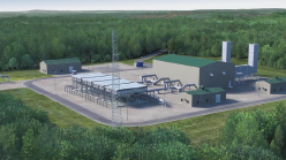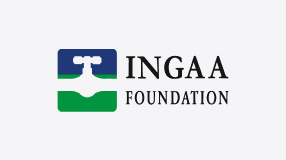Land movement, particularly in variable, steep, and rugged terrain, can pose a threat to the integrity of a pipeline if those threats are not mitigated. The INGAA Foundation Inc. contracted Golder Associates Inc. to review mitigation efforts on pipeline alignments or rights of way (ROWs), in an effort to educate and inform those in the pipeline industry about the threats of land movement and outline practical mitigative measures.
Golder has provided geotechnical and hydrotechnical engineering and geologic hazard assessment support to pipeline companies in the Appalachian Basin and has used its experience, expertise an technical resources from previous work in the area to develop this document. Many areas in Appalachia, and particularly West Virginia, contain conditions with rugged terrain that is variable, steep,rugged, geologically diverse, and can be very wet. All of these factors can contribute to land movement that could threaten new and existing pipelines and ROW corridors. While this report specifically addresses issues found in Appalachia, the concepts outlined in this document are applicable to other areas in the U.S. and Canada with similar hydrologic, topographic and geologic conditions.
This study identifies a number of critical items when mitigating land movement on pipeline ROWs. These include:
- The importance of identifying landslide and erosion hazards, and incorporating that information into the design, planning and construction phases of a project. Mitigation efforts should be tailored to address site-specific conditions as well as to balance costs with practicality of installation, operation and mitigation of risk. Note, the identification and characterization of landslide and erosion hazards represents a science all by itself, and is not directly addressed herein. This document focuses on the mitigation efforts related to these hazards;
- The critical role of route selection in identifying and avoiding hazards that may impact pipelines and ROWs. Careful planning and routing is always preferred to avoid or minimize potential threats from landslide and erosion hazards, but mitigation is usually required when such hazards cannot be avoided;
- The need to incorporate site-specific mitigation measures into the project planning process, to address threats to the pipeline and the ROW. The cause of any given landslide or erosion hazard is commonly the result of several contributing factors. Defining the governing geologic hazard and geotechnical/hydrotechnical engineering processes that are contributing to the land movement is critical in supporting the selection, planning, and design of an effective mitigation plan. Ultimately, the owner/operator must decide on the acceptable level of risk for any given mitigation package;
- The association between land movement and surface and subsurface water in combination with changes in the local ground conditions from recent or historical changes in geologic conditions and/or construction-related activities. Examples of mitigation options that address these conditions include re-grading the ROW surface to improve site conditions, modifying local surface drainage, conveyance of sub-surface drainage, modified ROW backfill materials, deformable backfill in the pipeline trench, removal of unstable soil and replacement with engineered performance materials, ground surface erosion protection, slope breakers, trench breakers, special pipeline coatings and protective sleeve-wraps, modified ROW configurations, monitoring and special pipeline design. These options are typically used in combination to develop a strategy for addressing the identified hazards at any given site;
- Structural measures are also available to address unstable slopes, such as retaining walls, soldier piles, sheet piles, wire mesh systems, mechanically stabilized earth systems and other mechanical structures. These options can be costly, have special equipment and access requirements in order to install in steep slope conditions, may limit future access or Land Movement Mitigation in Rugged and Steep Terrain ii April 2016 expansion in constrained ROW corridors, and may also have special long-term maintenance requirements;
- Reducing ground disturbance through minimized ROW footprints, appropriately sized and applicable equipment, and planning construction during optimal seasonal conditions (i.e. dry versus wet) can minimize mitigation requirements;
- Consideration of the landslide and erosion processes, and the origin of the source(s) of water relative to the constructed pipeline ROW. In particular, mitigation measure selection shouldconsider the disturbed temporary ground surface from the initial grading of the ROW and subsequent construction work and not just the finished and restored ROW surface;
- Organizing mitigation options into a framework of Typical Scenarios and supporting Typical Details that are consistent with how the ROW is built (i.e. ridge top, planar slopes, side slope, etc.). This allows for rapid development of conceptual site-specific mitigation plans during project planning and design;
- Designing to mitigate for all or only portions of targeted threats from land movement, thereby allowing the owner/operator to decide and select the level of mitigated risk, and allowing time for the owner/operator to plan, assess and make risk-based decisions on how to best manage the asset.
The most effective mitigation strategy requires recognition of the multiple factors governing a site, and may require long-term performance monitoring before full mitigation can be achieved. In some situations, the mitigation may not be intended to provide a long-term permanent mitigation and full elimination of the hazard. Instead, the pipeline ROW is mitigated to an acceptable level of risk. As such, mitigation measures should be tailored to address the site specific and potentially variable conditions, consider the risk tolerance of the owner/operator, consider the costs and benefits of long-term and short-term solutions, and incorporate construction considerations into the planning and design efforts and integrate with the construction process.
While mitigation efforts will not prevent every landslide or all erosion hazards, comparison of mitigated versus un-mitigated cost risk suggest that a comprehensive program of proactive mitigation and implementation on a system-wide scale can significantly reduce overall risk in a pipeline system, and can provide compounding benefits over time.





